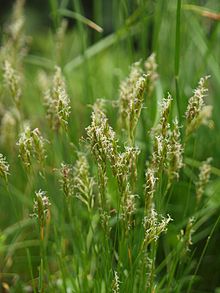Alpine stalk grass
| Alpine stalk grass | ||||||||||||
|---|---|---|---|---|---|---|---|---|---|---|---|---|

Alpine stork grass ( Anthoxanthum nipponicum ) |
||||||||||||
| Systematics | ||||||||||||
|
||||||||||||
| Scientific name | ||||||||||||
| Anthoxanthum nipponicum | ||||||||||||
| Honda |
The alpine stony grass ( Anthoxanthum nipponicum Honda , syn .: Anthoxanthum alpinum A. & D. Löve ) is a species from the sweet grass family (Poaceae).
features
The Alps-sweet vernal grass is a perennial , herbaceous plant . It reaches a height of 15 to 20 (40) centimeters.
The leaf blade is rolled up tubular. The gray-green, matte upper side is not visible, only the shiny, yellowish-green underside.
The flowers are in panicles . These are one to two inches long and yellow to reddish brown. The lemmas of the fertile flowers are covered at the top with short bristle hairs and are therefore rough. The hairs of the two upper glumes do not reach the tip, which is often surrounded by a skin edge. Flowering time is from May to July. It spreads via epi zoochory and anemochory .
The species is diploid and one of the tribe of the common stalk grass . The number of chromosomes is 2n = 10.
Occurrence
the distribution area of the alpine stony grass extends from Europe to Japan. It is distributed arctic-alpine. In Germany it occurs only in Bavaria (Alps, Bavarian Forest) and in Baden-Württemberg (Black Forest). It is quite common in Austria and Switzerland. In Austria it is only missing in Vienna, in the northern gneiss and granite country it is considered endangered.
The species grows in turf (especially bristle grass ) and dwarf shrub communities as well as in larch forests on moderately dry to slightly moist, poorly nutrient-rich, rather acidic soils. It thrives in plant communities of the associations Nardion strictae, Caricion fuscae and Caricion curvulae. The Alpine Ruchgras occurs in the (montane) subalpine to alpine altitude range , but mostly only above 1400 meters above sea level .
Taxonomy
Some authors (e.g. Flora of China) consider Anthoxanthum odoratum and Anthoxanthum nipponicum as subspecies of a species. Anthoxanthum nipponicum then receives the name Anthoxanthum odoratum subsp. nipponicum (Honda) Tzvelev (Syn .: Anthoxanthum odoratum subsp. alpinum (Á.Löve & D.Löve) BMGJones & Melderis ).
literature
- Manfred A. Fischer , Wolfgang Adler, Karl Oswald: Excursion flora for Austria, Liechtenstein and South Tyrol. 2nd, improved and enlarged edition. State of Upper Austria, Biology Center of the Upper Austrian State Museums, Linz 2005, ISBN 3-85474-140-5 .
- Erich Oberdorfer: Plant-sociological excursion flora . 7th edition, Ulmer, Stuttgart 1994, ISBN 3-8252-1828-7 .
- Siegmund Seybold (Ed.): Schmeil-Fitschen interactive (CD-Rom), Quelle & Meyer, Wiebelsheim 2001/2002, ISBN 3-494-01327-6 .
Individual evidence
- ↑ a b Erich Oberdorfer : Plant-sociological excursion flora for Germany and neighboring areas . With the collaboration of Angelika Schwabe and Theo Müller. 8th, heavily revised and expanded edition. Eugen Ulmer, Stuttgart (Hohenheim) 2001, ISBN 3-8001-3131-5 , pp. 263 .
- ↑ a b Rafaël Govaerts (Ed.): Anthoxanthum nipponicum. In: World Checklist of Selected Plant Families (WCSP) - The Board of Trustees of the Royal Botanic Gardens, Kew . Retrieved November 2, 2016.
Web links
- Alpine stalk grass. In: FloraWeb.de.
- Alpine stalk grass . In: BiolFlor, the database of biological-ecological characteristics of the flora of Germany.
- Profile and distribution map for Bavaria . In: Botanical Information Hub of Bavaria .
- Anthoxanthum alpinum Á. & D. Löve In: Info Flora , the national data and information center for Swiss flora . Retrieved September 30, 2015.
- Thomas Meyer: Data sheet with identification key and photos at Flora-de: Flora von Deutschland (old name of the website: Flowers in Swabia )
